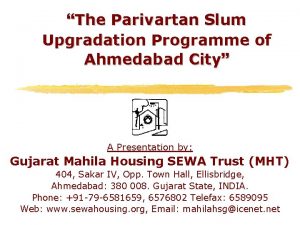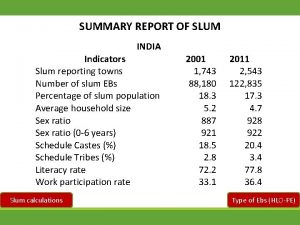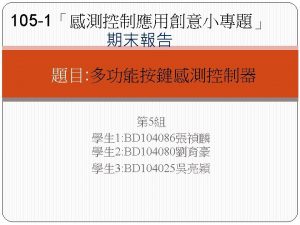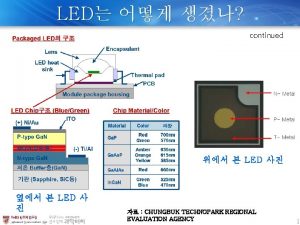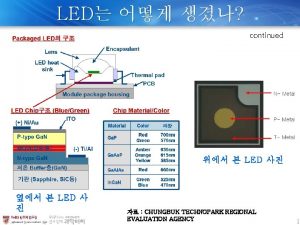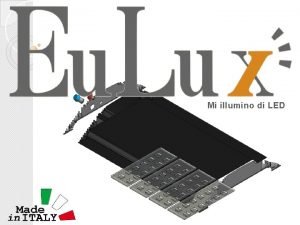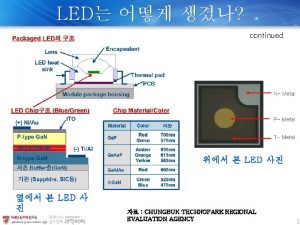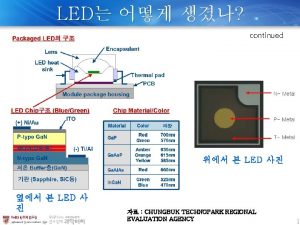STREET LED APPROACH IN SLUM UPGRADATION A slum
















- Slides: 16

STREET LED APPROACH IN SLUM UPGRADATION “A slum upgrading programme is not a collection of technical actions to be performed independently of each other. It is an integrated and comprehensive intervention aimed at improving the physical characteristics of a neighbourhood and its inhabitants’ quality of life” -Imparato, Ivo and Jeff Ruster (2003) By Akanksha pal Bishal Pokhrel Viral Patel

UNDERSTANDING STREETS IN SLUM • Streets as means to connect with the City • Streets support an incremental approach • Streets are social spaces for participatory planning • Streets are tools for inclusion, security and prosperity

STREETS AS MEANS TO CONNECT WITH THE CITY • Slums are deprived neighborhoods, spatially segregated and discontinued due to absence of streets & open spaces. • Taking advantage of streets as the natural conduits that connect slums with the city • Streets are vital elements in the improvement of quality of life in slums, particularly in densely occupied settlements where the absence of streets is the source of multiple problems faced by slum dwellers and the city as a whole • Integrating slums into the overall city planning and management and fostering urban regeneration.

STREETS SUPPORT AN INCREMENTAL APPROACH • streets as the key to linking up neighbours, businesses and economic activities situated adjacent to each other and sharing the common public space provided by the streets. • The incremental approach based on the prioritization of streets will ensure that strategic choices are made and that the streets selected for improvement or implementation initially are actually the ones that are likely to bring the best outcome in terms of development opportunities, poverty reduction, optimization of land use and generation of wealth as a result of increase in property values. • approach will also ensure that city level concerns for connectivity and mobility.

Streets are social spaces for participatory planning • This strategy uses streets not only as a physical entity for mobility and accessibility – through which water and sewerage pipes, power lines, and drainage systems are laid – but as the common good and the public domain where social, cultural and economic activities are articulated, reinforced and facilitated. • enables the participation of communities in generating reliable and accurate information on settlements, which forms the backbone of the street-led approach. Inventory of the physical configuration and spatial structure of the settlements; enumeration of housing units; determination of tenure conditions and income are properly recorded and endorsed by all parties prior to slum upgrading interventions. • Street-based participation is critical for prioritizing the streets and the future urban layout configuration of their neighbourhood, which forms part of an area-based plan that integrates their settlement with the overall city plan

STREETS ARE TOOLS FOR INCLUSION, SECURITY AND PROSPERITY • Streets trigger economic activity, attracting shops, services and increased residents’ identity with their place of residence, bringing an enhanced sense of security and orderly development • The introduction of public lighting and mixed use along a street’s route is likely to bring more usage and social interactions amongst residents with positive impacts on the sense of public safety • Street naming and house numbering establish physical addresses and locations, enabling residents to gain an address and postal code, the first steps in gaining citizenship rights.

Dharavi, Mumbai, depicting the absence of public space and streets. An inner neighborhood access street showing the difficulties for pedestrians Slum in Nairobi showing critical absence of streets and public space Slum, street rail pipe, Mumbai, India

A slum upgrading programme is not a collection of technical actions to be performed independently of each other. It is an integrated and comprehensive intervention aimed at improving the physical characteristics of a neighbourhood and its inhabitants’ quality of life.



The Street-led slum upgrading approach in a nutshell

UPGRADATION PLAN : Andhra Pradesh Urban Services for the Poor (APUSP) The Andra pradesh urban services for the poor(APUSP) was formed to upgrade 42 secondary towns. APUSP was aimed at sustainable poverty reduction through slum upgrading, municipal reforms to undertake and sustain poverty reduction, and strengthening civil society to invigorate the interaction between poor people and the municipality and to stimulate policies in favour of the poor. • The MAPP was an effective participatory tool for citywide prioritisation of slums for phased implementation, their connections with city systems and linking reforms with sustained poverty reduction. • The street-based micro-planning in slums ensured demand based service delivery and opening streets.

• preparing simple street maps • indicating the status of infrastructure and future requirements • consolidated into a slum level micro-plan by the NHC, which forms the basis for technical proposals, including road widening and paving.

Inference • Focus on streets and urban layout of the settlement, as the driver of transformation and regeneration (and subsequent street naming and addresses); • Maximize citizens’ participation and participatory planning; • Re-emphasising the importance of mapping through participatory enumeration and locally acceptable forms of social & physical mapping; • Continued basic infrastructure provision, e. g. water supply, sanitation, drainage; • Land allocation for resettlement and new housing provision. • Ensuring security of land tenure within slums, ultimately leading to regularization and legalization. • Incremental approach to integrating slums with the city


 Hpl street light
Hpl street light Research approaches definition
Research approaches definition Waterfall vs shower approach
Waterfall vs shower approach Approach to system development
Approach to system development Approach approach conflict
Approach approach conflict Deep learning approach and surface learning approach
Deep learning approach and surface learning approach A switched wan is normally implemented as a network
A switched wan is normally implemented as a network Cognitive approach vs behavioral approach
Cognitive approach vs behavioral approach Cognitive approach vs behavioral approach
Cognitive approach vs behavioral approach Poetic devices in elementary school in a slum
Poetic devices in elementary school in a slum Il gergo dello slum
Il gergo dello slum Meherjan lives in a slum
Meherjan lives in a slum Parivartan slum ahmedabad
Parivartan slum ahmedabad What property did meherjan lose due to river erosion
What property did meherjan lose due to river erosion Slum tourism definition
Slum tourism definition Slum and squatter difference
Slum and squatter difference Open handed map in elementary school
Open handed map in elementary school












